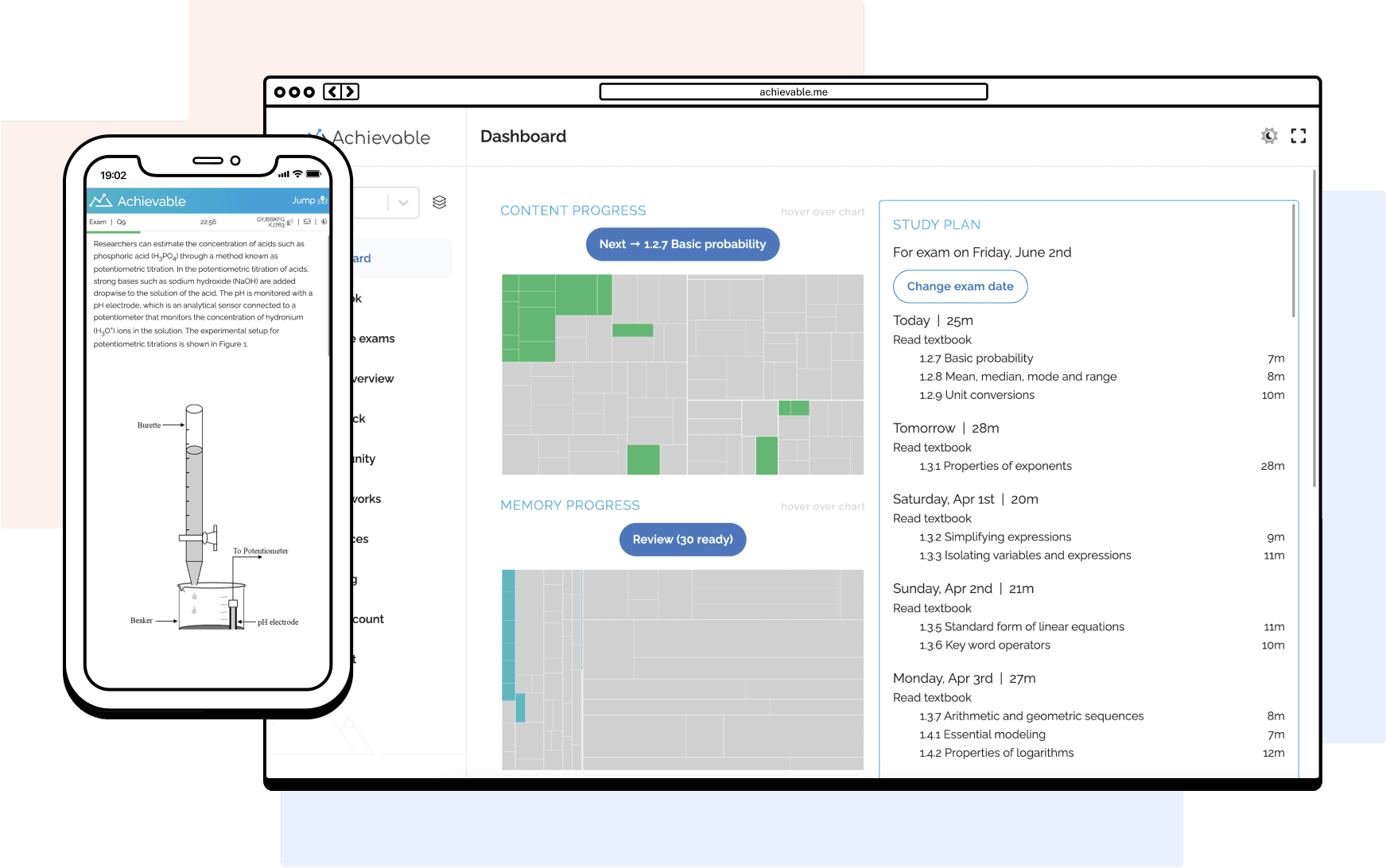

Free NPTE-PTA practice exam
Question 1
A patient with pericarditis asks why activity is so limited. What is the MOST appropriate explanation by the PTA?
A.
You are deconditioned and need rest
B.
Activity increases heart irritation, which can worsen inflammation.
C.
It's unsafe to move with chest pain
D.
You need to wait for blood tests to normalize.
Question 2
When reviewing the patient's arterial blood gas the findings are, pH: 6.2, PaCO2: 53, and HCO3: 24. After intervention the readings are now: pH: 7.2, PaCO2: 40, and HCO3: 28. Which condition does the patient have and what is their current status?
A.
Metabolic acidosis; fully compensated
B.
Respiratory alkalosis; uncompensated
C.
Metabolic alkalosis; compensated
D.
Respiratory acidosis; partially compensated
Question 3
A patient recovering from pulmonary fibrosis begins experiencing increased dyspnea during moderate activity despite using oxygen. What is a likely explanation?
A.
Medication non-compliance
B.
Anxiety
C.
Progressive scarring impairing oxygen diffusion
D.
Fluid overload
Question 4
A patient taking ACE inhibitors reports a persistent dry cough during therapy sessions. What is the most likely side effect causing this symptom?
A.
Beta-blocker bronchospasm
B.
Pulmonary embolism
C.
ACE inhibitor-induced cough
D.
Heart failure exacerbation
Question 5
A patient with a history of smoking presents with chronic cough, wheezing, and dyspnea. Spirometry shows a FEV1/FVC ratio of 58%. According to the GOLD guidelines, what stage of COPD is this patient most likely in?
A.
Stage 2 (Moderate).
B.
Stage 1 (Mild)
C.
Stage 3 (Severe)
D.
Stage 4 (Very Severe)
Question 6
A patient presents with ABG values: pH 7.47, PaCO₂ 33 mm Hg, HCO₃⁻ 23 mEq/L. What is the most appropriate interpretation?
A.
Compensated metabolic alkalosis
B.
Respiratory acidosis
C.
Metabolic acidosis
D.
Uncompensated respiratory alkalosis
Question 7
Which of the following instructions should be given to a patient using a short-acting bronchodilator prior to chest percussion?
A.
Use the medication 15 minutes before therapy to optimize airway dilation
B.
Only use the bronchodilator after chest PT to avoid mucus mobilization
C.
Do not use medication on chest PT days
D.
Use the bronchodilator only once daily
Question 8
Which lung volume measurement would be most affected in a patient with emphysema and hyperinflation on imaging?
A.
Decreased tidal volume
B.
Increased residual volume
C.
Increased inspiratory reserve volume
D.
Decreased expiratory reserve volume
Question 9
Which technique would most beneficial in treatment of patient with forward head positioning and diffuse cervical neck pain?
A.
Strengthen pecs
B.
Strengthen deep cervical flexors and scapular retractors
C.
Stretch rhomboids
D.
Increase upper trap activation
Question 10
A patient with a recent total knee arthroplasty is experiencing difficulty with knee extension during the stance phase of gait. What is the most likely reason for this dysfunction?
A.
Pain in the knee joint
B.
Poor proprioception
C.
Quadriceps weakness.
D.
Lack of knee flexion during swing phase
Question 11
A 36-year-old female reports low back pain and pelvic pain after stepping off a curb. She has pain with sidelying compression, shorter left leg, and antalgic gait. What is the likely treatment?
A.
Strengthen hip adductors on right side
B.
Strengthen quadratus lumborum on left side
C.
Stretch gluteus medius on right side
D.
Stretch iliopsoas on left side
Question 12
An older adult presents with chronic low back pain that worsens with extension and standing, and improves with sitting. MRI shows central canal narrowing. What is the most likely cause?
A.
Spondylolisthesis
B.
Facet joint degeneration
C.
Spinal stenosis
D.
Disc herniation
Question 13
All of the following are side effects of Acetaminophen except:
A.
Acne
B.
Indigestion
C.
Headache
D.
Thrombophilia
Question 14
A 38-year-old office worker presents with neck pain radiating to the lateral forearm and thumb. The pain worsens with prolonged typing and turning the head to the same side. Spurling's test is positive. What is the likely diagnosis?
A.
Carpal tunnel syndrome
B.
Thoracic outlet syndrome
C.
Cervical radiculopathy
D.
Pronator teres syndrome
Question 15
A distance runner complains of deep aching in the anterior leg during exertion, relieved by rest, with no sensory loss. What is the most likely diagnosis?
A.
Shin splints
B.
Tibial stress fracture
C.
Anterior tibialis strain
D.
Chronic exertional compartment syndrome
Question 16
A patient with suspected hip labral tear reports clicking and catching. Which test is most appropriate for labral pathology?
A.
FABER Test
B.
FADIR Test
C.
Thomas Test
D.
Ely's Test
Question 17
A patient reports SI joint pain during transitional movements. What test would help confirm SI joint dysfunction?
A.
FABER Test
B.
Straight Leg Raise Test
C.
Thigh Thrust Test
D.
Trendelenburg Test
Question 18
A tennis player presents with lateral elbow pain. What special test would most accurately confirm the suspected diagnosis of lateral epicondylitis?
A.
Tinel's Sign at the elbow
B.
Cozen's Test
C.
Phalen's Test
D.
Mill's Test
Question 19
A 60-year-old male with bulbar palsy presents with difficulty swallowing and slurred speech. What is the most important medical intervention to address these symptoms?
A.
Modified diet and speech therapy focusing on swallowing techniques.
B.
Full liquid diet and oxygen therapy
C.
PEG tube insertion
D.
Use of voice amplifier for communication
Question 20
A physical therapist is evaluating a toddler with known gross and fine motor delays. Which test would provide detailed developmental age equivalency across multiple motor domains?
A.
Peabody Developmental Motor Scales – Second Edition (PDMS-2)
B.
BOT-2
C.
AIMS
D.
GMFM
Question 21
Which motor pattern is most often delayed in children with autism?
A.
Muscle tone development
B.
Reciprocal locomotion and motor planning
C.
Reflex integration
D.
Protective reactions
Question 22
A patient presents with muscle atrophy, decreased tone, and hyporeflexia in the right lower extremity. What type of lesion is suspected?
A.
Upper motor neuron lesion
B.
Cortical stroke
C.
Cerebellar lesion
D.
Lower motor neuron lesion
Question 23
A patient with Parkinson's disease is demonstrating bradykinesia and resting tremors during treatment. Which neurotransmitter deficiency is responsible for these symptoms?
A.
Serotonin
B.
Acetylcholine
C.
Glutamate
D.
Dopamine
Question 24
A 68-year-old patient with right-side hemiparesis post-stroke is hesitant to use the affected upper limb during daily tasks. What is the best strategy to promote limb use?
A.
Constraint-induced movement therapy
B.
PNF bilateral D2 flexion patterns
C.
Task-specific training of the unaffected limb
D.
Mirror box therapy
Question 25
A patient with spinal cord injury C6 would benefit from all of the following manual wheelchair adaptations except?
A.
Knobby tires
B.
Lightweight folding chair
C.
Elevating leg rests
D.
Increased angle of dump
Question 26
A hyperextension injury characterized by damage to the dorsal column medial lemniscus tract is also referred to as
A.
Central cord injury
B.
Posterior cord injury
C.
Anterior cord injury
D.
Brown-Sequard injury
Question 27
A PT is comparing outcomes between three different intervention groups. Which statistical test should be used?
A.
Paired t-test
B.
Chi-square test
C.
ANOVA
D.
Pearson correlation
Question 28
How should the PTA measure the height of a ramp according to ADA guidelines for wheelchair access?
A.
The ramp should have a ratio of 1:12 (1 inch rise for every 12 inches of horizontal distance).
B.
The ramp should have a 1:8 ratio
C.
Measure the ramp based on the door height
D.
Allow for a 1:10 ratio.
Question 29
A PTA notices that a patient is exhibiting signs of increased fatigue and shortness of breath during gait training. What is the appropriate response from the PTA?
A.
Continue the session with rest breaks
B.
Adjust intensity and monitor symptoms
C.
Document the symptoms and proceed
D.
Stop treatment and notify the supervising PT.
Question 30
A patient with a complete T10 SCI is beginning ambulation training. Which assistive device and orthosis combination is MOST appropriate?
A.
AFOs with crutches
B.
HKAFOs with canes
C.
KAFOs with a walker
D.
No orthosis with crutches
Question 31
What skin change in a mole is considered a warning sign of melanoma?
A.
Even pigmentation and circular shape
B.
Asymmetry and irregular borders.
C.
Smooth surface and uniform color
D.
Stable size over several years
Question 32
A patient with Addison's disease is being seen for endurance training. What is a critical symptom to monitor for during exercise?
A.
Hypotension and signs of fatigue.
B.
Sudden hyperactivity and tremors
C.
Muscle hypertrophy
D.
Visual hallucinations
Question 33
What psychological condition may present with cyclic moods, including episodes of mania and depression?
A.
Panic disorder
B.
Obsessive-compulsive disorder
C.
Bipolar disorder.
D.
Post-traumatic stress disorder
Question 34
A 75-year-old immobile patient develops a deep, open wound over the sacrum exposing muscle tissue. The surrounding skin is red and warm, and there is a foul odor. What is the correct classification of this pressure injury?
A.
Stage 2 pressure injury
B.
Stage 4 pressure injury
C.
Deep tissue pressure injury
D.
Stage 3 pressure injury
Question 35
A physical therapist assistant is treating a patient with a stage 3 pressure injury. Which of the following structures is MOST likely exposed?
A.
Muscle
B.
Tendon
C.
Subcutaneous fat
D.
Bone

Pass the NPTE-PTA. Guaranteed.
Achievable is the best online NPTE-PTA exam prep course: effective, personalized, and convenient. With Achievable, you'll spend less time studying and pass your exam the first time, or your money back.